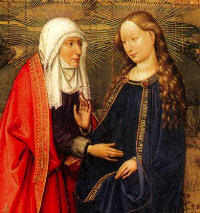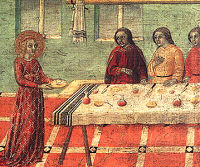The Feast of the Visitation is an ideal time to consider the joy of carrying Jesus to others. Authentic Christian joy is an infallible sign of the Holy Spirit. Father Francis Fernandez wrote, “A gloomy soul is at the mercy of many temptations.”
Luke’s gospel states, “When Elizabeth heard Mary’s greeting, the infant leaped in her womb, and Elizabeth, filled with the Holy Spirit, cried in a loud voice and said, “Most blessed are you among women, and blessed is the fruit of your womb. And how does this happen to me that the mother of my Lord should come to me? For at the moment the sound of your greeting reached my ears, the infant in my womb leaped for joy. Blessed are you who believed that what was spoke to you by the Lord would be fulfilled” (Lk. 1:39-45).
I have contemplated this scripture scene over the past eighteen years because I serve the Church through the ministry of Magnificat which is based on the Visitation scene. There are two points I’d like to make in this brief reflection on the Visitation scene: first, the joy of carrying Jesus to others and secondly, the need to pray for healing of the “mother wound”.
Sharing the Joy
The joy of the scene of the Visitation can present a challenge against gloominess. Father Fernandez wrote, “Joy is to possess Jesus; unhappiness is to lose him. A gloomy soul is at the mercy of many temptations. How many sins have been committed in the shadow of that gloominess! When the soul is happy is spreads its happiness and is an encouragement to others. When it is downcast it spreads its misery and does harm to others. Sadness springs from egoism, from thinking about oneself to the exclusion of others, from laziness in one’s work, from lack of mortification, from the search for small self-indulgences, from carelessness in one’s relationship with God. Anyone excessively self centered will find it very difficult to discover the joy of opening himself out towards God and towards other people.” (Francis Fernandez, In Conversation with God, Vol. 1, pg 117)
After meditating on the joy of the Visitation scene and Father Fernandez’s teaching, I found myself praying thus:
Dear Mary, you brought joy to Elizabeth and to her baby, John, because you carried the Incarnate Word to the house of Zechariah. Your humble soul magnified the Lord in your womb and you could not contain the jubilation of your heart. Your soul rejoiced in God your Savior! Your hymn of praise has never ceased and your joy is complete forever. Mary, help me to carry Jesus to others also since we are all called to be Christ-bearers! Teach me to echo your praise so my soul magnifies the Lord and my spirit rejoices in God my Savior! Mary, help me to surrender my gloominess and embrace the joy of the Lord. Help me sow seeds of joy as I serve my brothers and sister for love of God. O living tabernacle of God, I want to be like you—a holy house of God filled with joyful love! Amen.
A Healed Heart is Joyful
There is sometimes a need to pray for the healing of the “mother wound”. At the Visitation scene there are four persons present in this scene: Mary, Elizabeth, Jesus and John the Baptist. The two chosen women are experiencing unplanned pregnancies. The two holy infants in their mother’s womb are experiencing their mother’s emotion, namely, jubilation. This scripture reflects the truth that a child in the womb perceives their mother’s emotion. While Mary and Elizabeth provide the perfect disposition of maternal charity toward their unborn children, some mothers have been unable to provide that for their unborn child. I found myself praying for the healing of the “mother wound” in this way:
Dear Lord, John the Baptist “leaped for joy” (Lk 1:45) at the visitation of your holy Mother. This reflects the truth of what goes on in the womb of a mother—the baby she carries perceives what is happening in his mother and in her world. Therefore, I too perceived something of my mother’s emotions and her world when I was in her womb. If what I perceived was less than welcoming love, please heal me of any wounds unknowingly inflicted upon my person from when I was in my mother’s womb. Jesus, you are outside time and space and you make all things new through an experience of your healing love. Please re-fashion me into your healed child. Amen.
As the Church’s liturgy celebrates the grace of the Visitation scene, it is a good occasion to ponder what is the level of joy in your heart? Has something robbed you of joy and moved you into gloominess? Consider praying for healing. Jesus is the healer of souls and the restorer of joy. I often bring my gloominess to the confessional where I am healed of many wounds through Christ’s chosen instrument of healing, the priest in the confessional. Sin is a thief of joy. After the grace of a good confession, my soul is free to magnify the Lord again. With Mary I find myself proclaiming His marvelous deeds with joy as I echo her hymn of praise, the Magnificat. Let us together magnify the Lord! As my good priest spiritual director often tells me, “There is no sad saint!”

 31st
31st  How lyrical that is, the opening sentence of St. Luke's description of the Visitation. We can feel the rush of warmth and kindness, the sudden urgency of love that sent that girl hurrying over the hills. "Those days" in which she rose on that impulse were the days in which Christ was being formed in her, the impulse was his impulse.
How lyrical that is, the opening sentence of St. Luke's description of the Visitation. We can feel the rush of warmth and kindness, the sudden urgency of love that sent that girl hurrying over the hills. "Those days" in which she rose on that impulse were the days in which Christ was being formed in her, the impulse was his impulse.  It is probable that Aurelia Petronilla was of the imperial family of the Flavii. The early traditions of the Church speak of her as being the spiritual daughter of the Prince of the Apostles; and though she did not, like Domitilla, lay down her life for the faith, she did offer to Jesus that next richest gift, her virginity. The same venerable authorities tell us also that a Roman Patrician, by name Flaccus, having asked her in marriage, she requested three days for consideration, during which she confidently besought the aid of her divine Spouse. Flaccus presented himself on the third day, but found the palace in mourning, and her family busy in preparing the funeral obsequies of the young virgin, who had taken her flight to heaven, as a dove that is startled by an intruder's approach.
It is probable that Aurelia Petronilla was of the imperial family of the Flavii. The early traditions of the Church speak of her as being the spiritual daughter of the Prince of the Apostles; and though she did not, like Domitilla, lay down her life for the faith, she did offer to Jesus that next richest gift, her virginity. The same venerable authorities tell us also that a Roman Patrician, by name Flaccus, having asked her in marriage, she requested three days for consideration, during which she confidently besought the aid of her divine Spouse. Flaccus presented himself on the third day, but found the palace in mourning, and her family busy in preparing the funeral obsequies of the young virgin, who had taken her flight to heaven, as a dove that is startled by an intruder's approach.